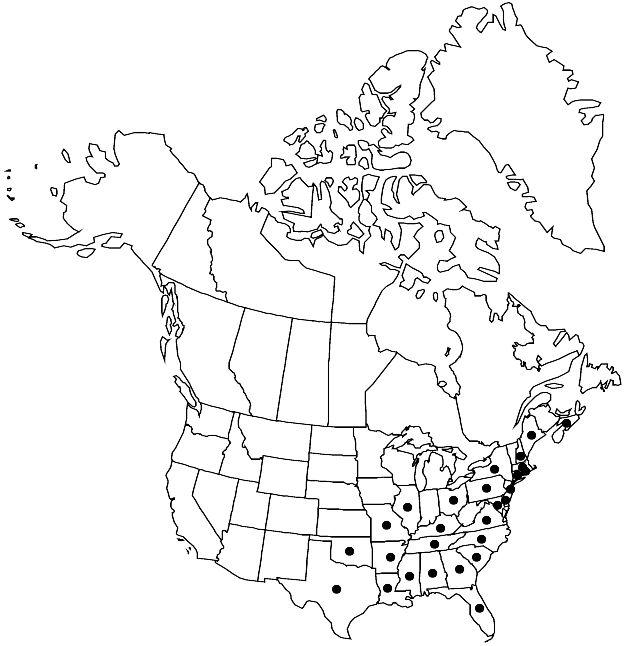Fontinalis sullivantii
Öfvers. Finska Vetensk.-Soc. Förh. 12: 78. 1870.
Plants to 25 cm, dark green, green, yellowish, or pale green. Stems slender to medium, rigid or flaccid; stem and branch apices short- or tightly long-attenuate; axillary hairs 480–600 µm, 6–10 cells, basal cell quadrate, red, distal cells long-cylindric, hyaline or reddish. Leaves dimorphic, differing greatly in size. Stem leaves loosely erect to erect-spreading when dry or moist, narrowly lanceolate to linear, subconcave at base, plane, concave, or tubular distally, 2–6(–9) mm; margins plane at apex; apex acuminate, acute, or subobtuse; medial laminal cells 80–150 × 4–8 µm. Branch leaves 2–4 mm. Perigonia with leaves 1–1.2 mm. Perichaetia with leaves oval to suborbiculate, 2–3 mm, apex obtuse. Seta 0.2–0.3 mm. Capsule immersed to slightly emergent, narrowly cylindric, 1.7–2.5 mm; operculum conic, 0.8–1 mm; endostome trellis imperfect. Calyptra 1–1.3 mm. Spores 12–20 µm.
Habitat: Rock, roots, tree bases, logs, sticks, twigs, streams, sloughs, swamps, pools
Elevation: low to moderate elevations (0-600 m)
Distribution

N.S., Ala., Ark., Conn., Del., Fla., Ga., Ill., Ky., La., Maine, Md., Mass., Miss., Mo., N.H., N.J., N.Y., N.C., Ohio, Okla., Pa., R.I., S.C., Tenn., Tex., Va., n Europe.
Discussion
Plants of Fontinalis sullivantii in pools or slow moving streams have flaccid stems and limp, plane leaves; those in fast moving streams have rigid stems and stiff, subtubular branch leaves. Plants of F. sullivantii can vary considerably in branching pattern (regular or sparse) and stem leaf length (4 or more versus 3 or less mm). Fontinalis sullivantii has four major expressions (B. H. Allen 1991) that have somewhat discrete ranges. Recognizing them at the species level is unwarranted because of many collections of intermediate morphology.
Fontinalis dalecarlica resembles rigid forms of F. sullivantii but has monomorphic leaves that are strongly concave when moist and flattened when dry, with narrowly reflexed margins. Fontinalis welchiana and the aestivalis expression of F. sphagnifolia often have weakly dimorphic leaves and can have the same flaccid aspect as F. sullivantii. They differ in having strongly concave branch leaves with erect to incurved apical margins. Fontinalis redfearnii is the only other Fontinalis species with such strongly dimorphic leaves. Fontinalis redfearnii differs from all forms of F. sullivantii in having broadly obtuse stem leaf apices.